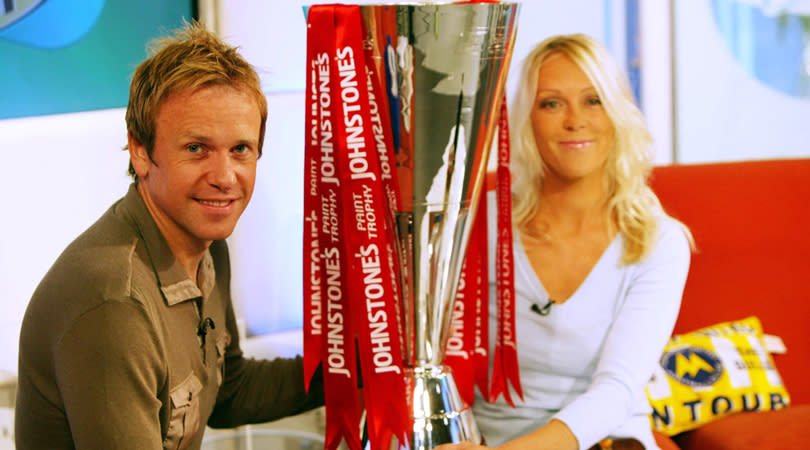What happened, Soccer AM? The slow, painful death of a Saturday morning staple

The Friday night chippy tea; Match of the Day on a quiet Saturday night in; moaning about a hangover on Sunday mornings. Nope, it’s not FFT’s heart-threatening weekend ritual but just some of the staples us Brits can’t resist. And no matter what we may care to admit now, watching Soccer AM on a Saturday morning was just another thing most of us used to do.
In its heyday the show was genuinely influential; brimming with funny skits, mesmerising tricks in Skill Skool, off-piste interviews, fan interaction, side-tickling clips caught on Third Eye, and every seat on the sofa taken up a big star guest. Regular features like Crossbar Challenge, Team-mates, Taxi!, Big Tackle and Kung Fu Academy helped endear the show to an expectant audience.
But now most of them are gone – and, somewhere along the line some time ago, the majority of viewers went with them. According to official audience-counters BARB’s per-channel weekly top 10, in the first half of the last decade the show regularly attracted a third of a million viewers – an enormous number for Sky Sports at the time, usually its largest audience outside the major live matches. But even as Sky’s subscriber pool grew, Soccer AM’s core audience dropped – to around 200k by 2009, below six figures by 2011 and, as Sky’s live coverage expanded, out of the top 10. The 2016 Christmas special got just 61,000 viewers.
Same old?
Since Soccer AM’s opening season in 1995, the running time of the show has been cut by almost two-thirds. Between 1995 and 2001 it lasted a whopping four hours, and was then cut down to three for the next nine years until 2010. Today it barely nudges the 90-minute mark.
It’s not the only thing that’s been chopped down: the studio has suffered a similar fate. What was once a sprawling area with several different elements, including a catwalk, stand for the week’s featured fans and space for mini-games, is now just a small floor. All that remains is the iconic couch set-up itself, which sits in a crammed studio with an audience and the gaggles of supporters they’ve roped in for the morning.
Well, that and the still-excellent Helen Chamberlain – a redeeming veteran of the show since 1995, and whose on-screen relationship with Tim Lovejoy was a genuine draw for 12 years. Lovejoy got out in 2007, and despite having released one of the most nauseating autobiographies of all time shortly after (a highlight: “I have always thought that women and football was, inherently, a bad combination”), the cocksure rent-a-gob probably timed it about right.
So why did we all stop watching?
Enjoyed the moment Tim Lovejoy realised he left a football show for a cooking program https://t.co/kgcPe2rCMQ
— London24 Sport (@London24Sport) January 29, 2015
Social media boom
Social media hasn’t helped, delivering Soccer AM’s sought-after tit-bits throughout the week, quicker and far more regularly than the show ever could. Thanks to the emergence of services like Twitter, Facebook and Vine, not even poor blokes in obscure Eastern European confines can escape worldwide ignominy before they even make it back to the dressing room.
For so long Soccer AM benefitted from Sky’s near-monopoly on football coverage, but the widespread availability of footage elsewhere – legal or otherwise – has left them floundering in a fast-moving current.
Yet those snippets weren’t the only reason so many people tuned in over toast and marmalade. The audience came for the clips but stayed for the sketches; iconic characters like Sheephead, Robbie Knox, Tubes, Rocket and Frankie Fryer, whose ragged revues would humorously pastiche the real world that chugged on around them. But some of these characters haven't aged well, becoming self-aware caricatures, the gags long grown old and imbecilic. This is now Bullard banter for the millennials; for those #lads at the back of the bus who’d have had Crazy Frog blaring out in 2005.
There used to be a catchphrase on its Yorkshire News segment that “change is not good” – but somewhat ironically for Soccer AM, it feels like that’s a strategy they’ve followed despite the environment around them insisting they must. In reality they should have a monopoly on Saturday mornings – really, it’s either that or the news over your cornflakes – yet they’ve still had their show time cut badly, found good guests harder to come by and, as a result, lost viewers.
Next-gen reality
Not so long ago Soccer AM was dictating much of football culture – it’s the show that popularised the word ‘tekkers’, and still encourages park footballers across the country to eye up a crossbar at the earliest available opportunity. Now it’s fallen behind in an age they couldn’t keep up with, like the dad who thinks he’s down with the kids but really needs to just let it go.
Is there a way back towards nationwide popularity? Well, probably – but only if you’re under the age of 20. It’s clear their name still has value: there’s a large digital audience to reach out to, with over 800k Twitter followers, 240k Instagram followers, 650k Facebook likes and an active presence on Snapchat.
In reality, then, the old-school Soccer AM viewer has been irrelevant for quite some time; left to wince and eye-roll about a show that lost its lustre a long time ago, and will most likely continue relying on the same schtick for a younger audience unfamiliar with its former glories.
